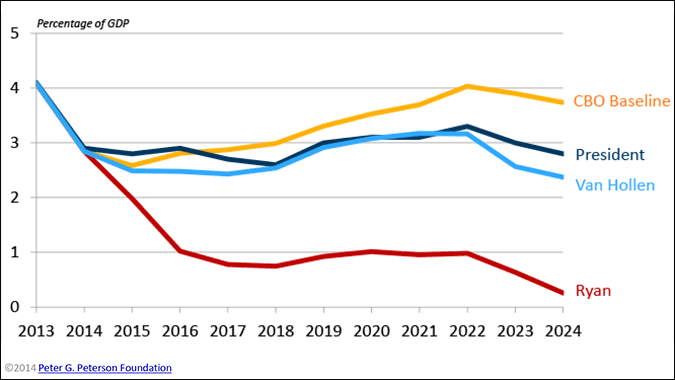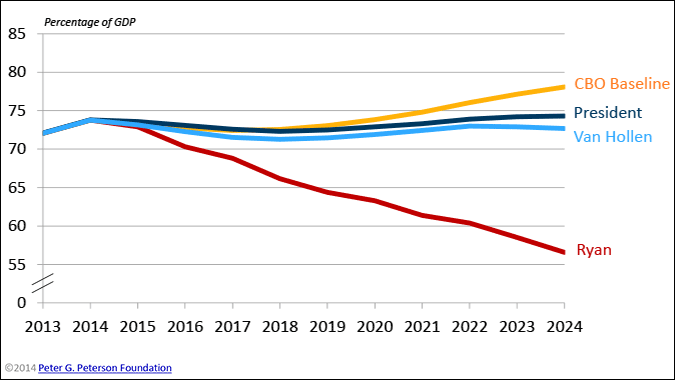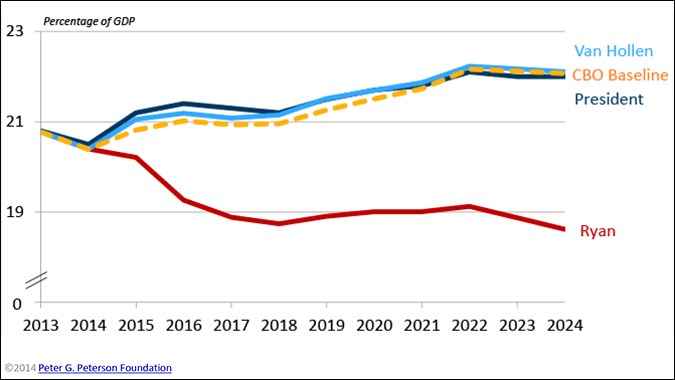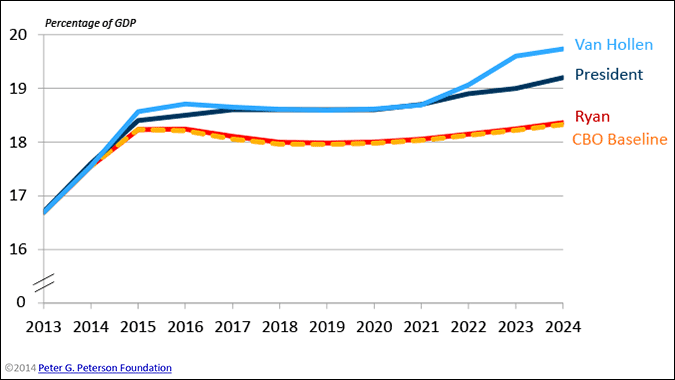You are here
FY 2015 Budgets: Comparing the President's, Chairman Ryan's and Ranking Member Van Hollen's Budgets
Today, the Congressional Budget Office (CBO) released its Analysis of the President’s 2015 Budget. In this new report, CBO estimates the budgetary impact of the President’s proposals using the same economic and technical assumptions that CBO uses for scoring legislation from the Congress. Compared to current law, CBO estimates that the President’s budget would increase spending by $338 billion over 10 years. Over the same period, the President’s budget would raise taxes by $1.4 trillion. As a result, 10-year deficits would be reduced by slightly more than $1 trillion under the President’s budget.
This new data provides an opportunity to make “apples-to-apples” comparisons between the President’s proposals and those that have emerged from the Congress. In the past month, both Republicans and Democrats in the House of Representatives have advanced alternative budgetary proposals that outline their priorities for the coming decade. House Budget Committee Chairman Paul Ryan (R-WI) released his budget on April 1. The Ranking Member on the House Budget Committee, Congressman Chris Van Hollen (D-MD), presented an alternative budget on April 7. On April 10, the House approved Chairman Ryan’s budget.
All three budget plans (President, Ryan, Van Hollen) achieve deficit reduction within the 10-year window relative to current law, though they make different choices on revenues and spending levels for particular programs and achieve different results. Chairman Ryan’s proposal achieves greater deficit reduction using spending cuts, while the President and Congressman Van Hollen advocate for a more modest deficit reduction using increases in revenues.
Unfortunately, the Senate leadership has opted not to pursue a budget resolution for Fiscal Year (FY) 2015, which represents a missed opportunity to present their view on the tough choices necessary in the fiscal debate. Last year, both the House and Senate proposed and passed budget resolutions for FY 2014 and worked out their differences in a conference committee. Because that agreement set limits on annually appropriated (discretionary) spending through FY 2015, Senate leaders have expressed the view that a budget resolution is unnecessary. However, discretionary spending represents only one-third of total spending and without a Senate budget resolution this year, Congress won’t be able to use the “regular order” process to make the larger budgetary tradeoffs necessary to address our fiscal challenges.
COMPARING THE THREE BUDGETS
Ryan: In the FY 2015 budget, Ryan proposes to bring deficits below one percent of gross domestic product (GDP) by 2017 and balances the budget by the end of the decade. The plan achieves deficit reduction entirely through net spending cuts, with nearly half of these cuts coming from the healthcare programs, including the repeal of the 2010 Affordable Care Act (“Obamacare”). Compared with current law, the Ryan budget would reduce 10-year deficits by $5.8 trillion.
Van Hollen: Deficits in Van Hollen’s FY 2015 budget are lower than they would be under current law, but they do not decline significantly over the 10 year period as a share of GDP. Instead, deficits fluctuate between 2.3 percent of GDP and 3.1 percent of GDP. Compared to current law, the Van Hollen budget would reduce 10-year deficits by about $1.5 trillion. The 10-year deficit reduction under the Van Hollen budget is due to net increases in revenues. Although Van Hollen cuts spending for some programs, those savings are offset by increases in other areas.
President: The President’s budget would reduce the deficit by a smaller amount than either the Ryan or Van Hollen budget. Compared to current law, the President’s plan would reduce 10-year deficits by a $1 trillion. This deficit reduction comes entirely from higher revenues, some of which are used to fund a $338 billion increase in net spending over 10 years.
It’s important to note that while the 10-year perspective is the standard budgetary window, that limited time frame fails to present a full picture of America’s fiscal outlook. The primary drivers of America’s long-term debt won’t become fully evident until the second decade and subsequent periods. Over the long term, America faces a number of structural fiscal challenges: baby boomers retiring in large numbers and living longer; growing costs from health care and interest payments; and a tax system that raises insufficient revenue to fund the obligations and promises that have been made. All of these trends threaten to crowd out the critical public and private investments that would ensure a strong economy. Moreover, the lack of solutions puts the nation at risk of a future fiscal crisis. The proposed budgets take steps towards improving the fiscal outlook, but policymakers will need to go further in order to put the nation’s debt on a sustainable path for the long term.
The charts below illustrate various budget trends over the coming decade under the different budgets.
Deficits under fiscal year 2015 budget plans

SOURCE: Congressional Budget Office, Updated Budget Projections: 2014 to 2024 and An Analysis of the President’s 2015 Budget, April 2014; U.S. House of Representatives, Concurrent Resolution on the Budget — Fiscal Year 2015, report to accompany H. Con. Res. 96, Report 113-403, April 2014; and the House Budget Committee, The Democratic Alternative Budget, April 2014. Compiled by PGPF.
NOTE: Because the House budget plans do not include budgetary estimates for 2014, it is assumed that the plans will follow current law for that year. GDP projections are based on CBO's economic forecast.
Debt held by the public under fiscal year 2015 budget plans

SOURCE: Congressional Budget Office, Updated Budget Projections: 2014 to 2024 and An Analysis of the President’s 2015 Budget, April 2014; U.S. House of Representatives, Concurrent Resolution on the Budget — Fiscal Year 2015, report to accompany H. Con. Res. 96, Report 113-403, April 2014; and the House Budget Committee, The Democratic Alternative Budget, April 2014. Compiled by PGPF.
NOTE: Because the House budget plans do not include budgetary estimates for 2014, it is assumed that the plans will follow current law for that year. GDP projections are based on CBO's economic forecast.
Total spending under fiscal year 2015 budget plans

SOURCE: Congressional Budget Office, Updated Budget Projections: 2014 to 2024 and An Analysis of the President’s 2015 Budget, April 2014; U.S. House of Representatives, Concurrent Resolution on the Budget — Fiscal Year 2015, report to accompany H. Con. Res. 96, Report 113-403, April 2014; and the House Budget Committee, The Democratic Alternative Budget, April 2014. Compiled by PGPF.
NOTE: Because the House budget plans do not include budgetary estimates for 2014, it is assumed that the plans will follow current law for that year. GDP projections are based on CBO's economic forecast.
Revenues under fiscal year 2015 budget plans

SOURCE: Congressional Budget Office, Updated Budget Projections: 2014 to 2024 and An Analysis of the President’s 2015 Budget, April 2014; U.S. House of Representatives, Concurrent Resolution on the Budget — Fiscal Year 2015, report to accompany H. Con. Res. 96, Report 113-403, April 2014; and the House Budget Committee, The Democratic Alternative Budget, April 2014. Compiled by PGPF.
NOTE: Because the House budget plans do not include budgetary estimates for 2014, it is assumed that the plans will follow current law for that year. GDP projections are based on CBO's economic forecast.
